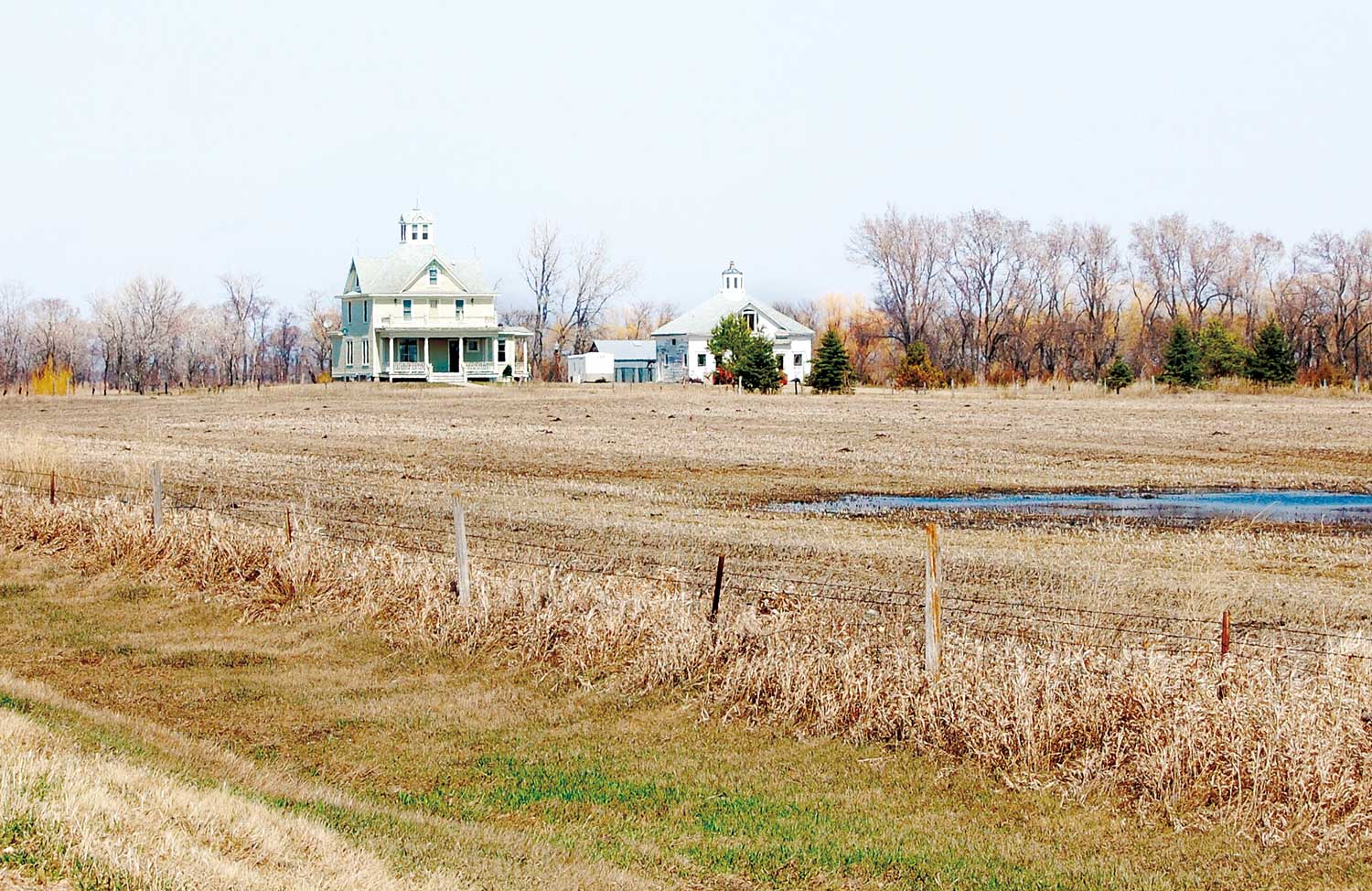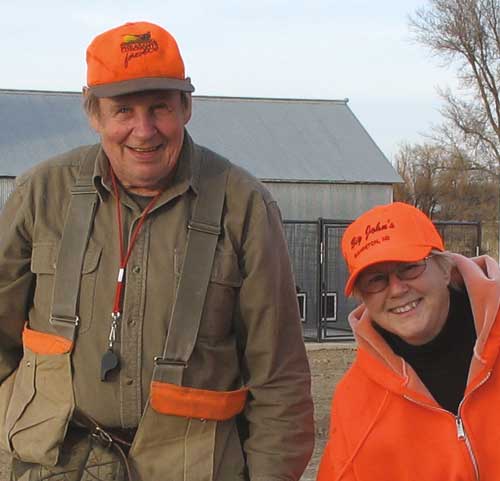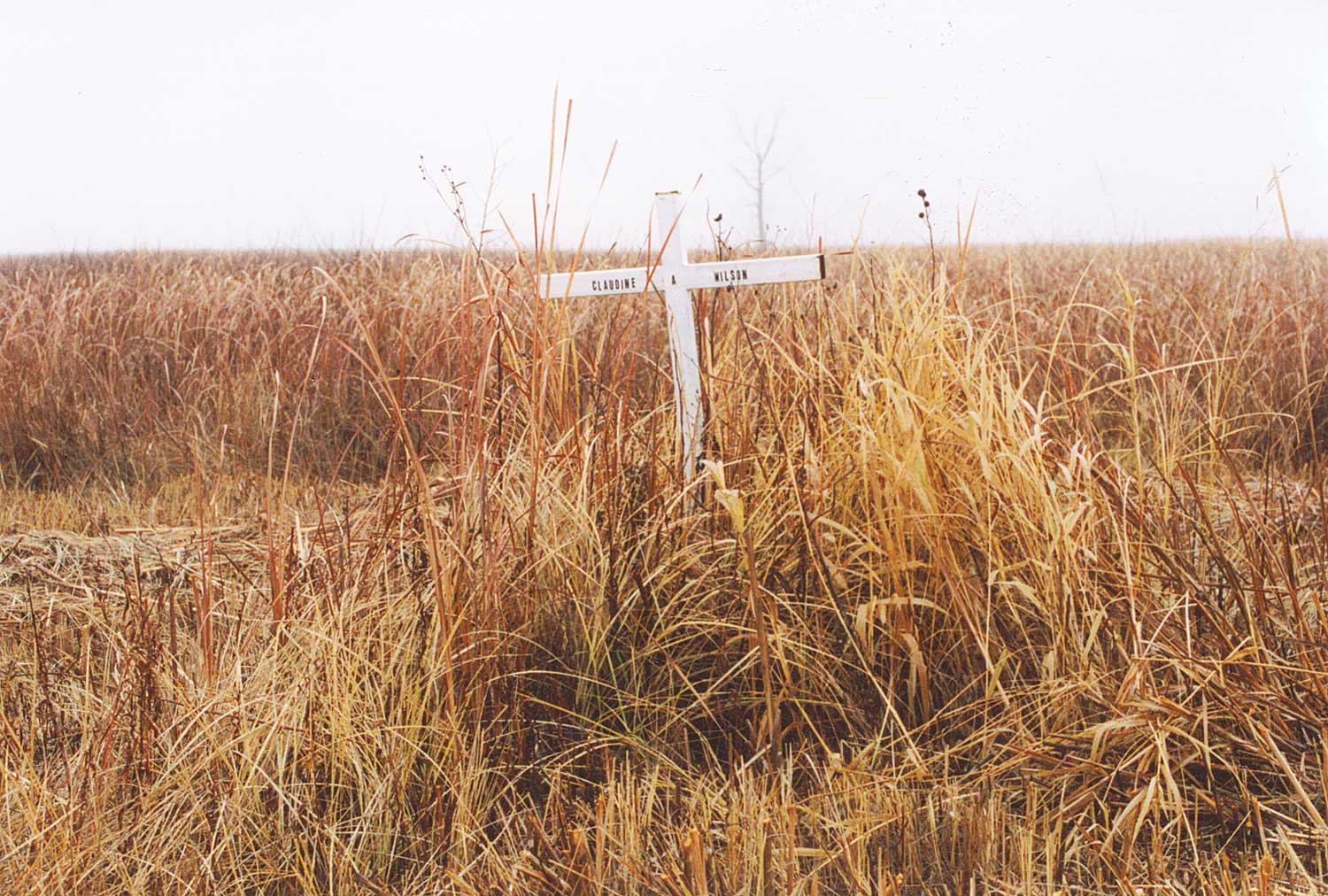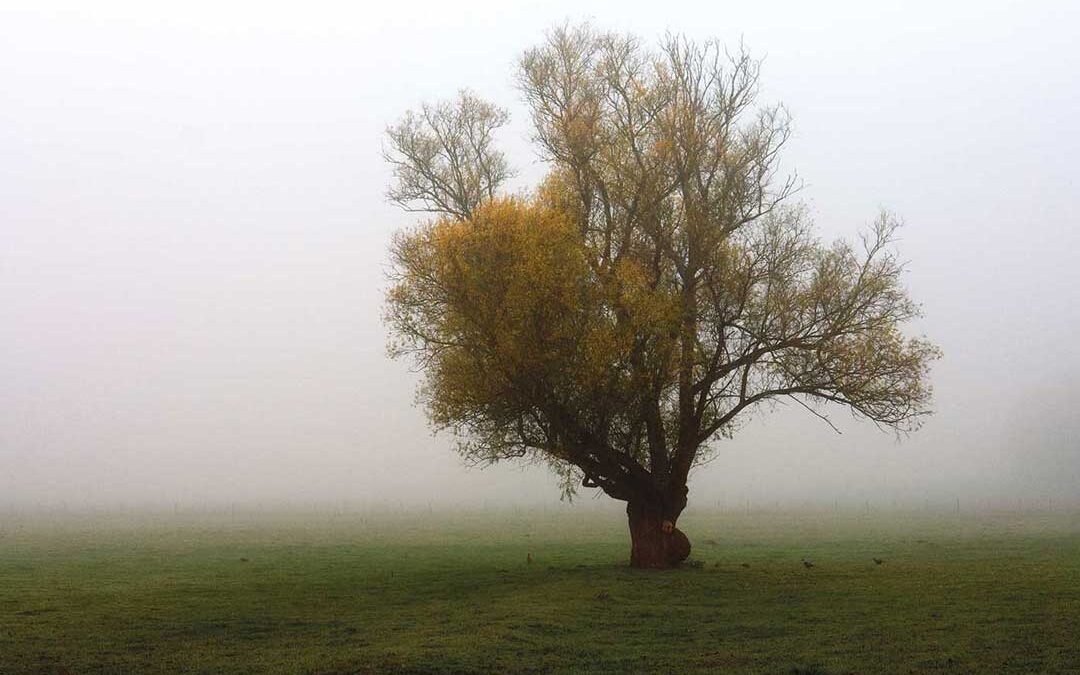The October sky darkens and melts into the horizon, hovering briefly between shades of cobalt blue and gray. Barren fields, pocked and ridged like a nuclear wasteland, stretch out on either side of the truck as we speed through the twilight, tires singing on the four-lane highway.
In the dim truck cab I peer closely at the map.
“The Wahpeton exit should be the next one,” I announce to Bob. “We get off there and then we head west, pass through three little towns and follow Jerry’s map to their place. Won’t be long now.”
After ten hours on the road, my husband hunches over the wheel, squinting for the green exit sign until I see a look of relief on his face. Our destination is close.
But Jerry had neglected to tell us that the “towns” comprise a stretch of another 50 miles of North Dakota landscape. Heading west now, the terrain changes. Rolling prairie on either side is intersected at regular intervals by long windbreaks that run perpendicular to the road, bending eastward but refusing to break under the relentless Dakota winds.

Water mirrors the slate sky – small ponds, larger waterways and immense lakes – incongruous and everywhere. A Northerner by birth, I expect lakes to be anchored by long stretches of sandy beach dotted with stones and driftwood, cradled by tall pines. Here, prairie meets water and meshes with no introduction, no small talk. An outsider might be walking along in the field and with his next step find himself immersed in water – water that has risen up, level with the prairie, right before his eyes.
We coast slowly into Wyndmere, the last dusty town on our map. A tavern, feed store and gas station cluster around the T of its main road and the highway. We decide to call Jerry and give him our whereabouts, in case we get lost in this strange land – sucked into a waterway or simply driving endlessly west, unable to find more civilization. Having no cell phone of our own, we notice, with sinking hearts, that the ancient phone outside the tavern parking lot is swinging, back and forth, from its base.
Inside, friendly tavern folk assure us the map is accurate and we’ll have no problem. You’re not far away now, they tell us, then return to their beers, smiling through a haze of blue smoke and country music.
Heading south now on a bumpy gravel road, we clock the miles on the odometer until we should, according to the map, come to the next gravel road. The roads have no markings, no signs. Along here, the water meets the road frequently – comes right up to the very edge, with no shoulder, no incline, to warn unsuspecting night travelers with bad eyes. I tense with anxiety. Any moment we could pass from gravel to water, from life to death.
“I think we’ve gone too far. Maybe we’re lost.” I lean over, trying to see the odometer.
Bob is unconcerned.
“Nah, we’re doing fine. And we can just stop and ask someone if we need to.”
I look at him, hard.
“Do you see anyone, anywhere, that we could stop and ask?”
We drive on in silence, surrounded by darkness, the truck headlights our only beacon in the encroaching fog. Tires crunch as we make the last turn, and finally, in the distance, we see it.
Rising like a giant phoenix in the night, amidst 5,000 acres of Dakota prairie, the three-story Victorian house welcomes us with lights ablaze. Our hosts are silhouetted in the warm glow, standing at the back porch, door ajar as they look out into the darkness.
Deerfield Farms is a game preserve, owned and operated by our friends, Jerry and Sandy Meide who live in Wahpeton, North Dakota, for part of the year and spend the remainder of it here at the preserve. Their business – construction and land development – fits neatly with their dream of restoration and preservation.
Our dogs groan and stir when the truck comes to a halt. Their last pit stop was several hours ago, and they bound out of their crates, albeit stiffly, and circle the damp grass, squatting with relief. They stretch, then run about and suddenly stop, noses uplifted, twitching, in the heavy, wet night air. One step, then another . . . they freeze . . . trembling with excitement.
This is pheasant country.
In autumn the smell of burning leaves heralds the harvest. Folks hustle about, choosing pumpkins and apples for pies and cider, and gathering cornstalks, straw bales and Indian corn to decorate their yards. Kids get ready for Halloween and woodpiles are stacked high for winter fires. Storm windows are put on. Hatches battened down. Folks draw together and gather at autumn bonfires, toasting the harvest, pressing close for warmth and reassurance.
There is another fall ritual. One that begins much earlier in the year. The bird hunter polishes his shotgun, oils his boots, conditions his dog with exercise. After a long day at work, he sits in the armchair, the dog at his feet, dreaming of the fall hunt as he pages through his favorite hunting magazine.
We train pointing dogs for a living at our kennels in northeastern Iowa and we are well acquainted with this ritual of fall – this rite of passage, often passed down from father to son. Over the years some great hunting dogs and many interesting folks have entered our lives, among them, Jerry and Sandy.
Deerfield Farms is their dream realized.

The sprawling Victorian farmhouse sat on a desolate tract of land several miles away, empty and neglected, nursing memories of years past. With the good bones necessary for successful renovation, the house was resurrected, moved to its present location and set on a new foundation where it breathes renewed life from the painstaking, loving restoration it’s undergone.
A tour of the old house shows rooms decorated in Victorian flavor, rooms that whisper of days gone by, ghosts smiling in the corners, nodding approval at our awe. We have our choice of one of seven bedrooms, each a welcoming, cozy combination of patchwork quilts, soft colors and antique furniture. Our bathroom across the hall features a clawfoot tub and a toilet with an overhead tank and pull chain. After a late supper, we settle in our room, the North Dakota wind whispering gently at the windows.
In the morning our indoor tour concludes with a look at our hosts’ bedroom, occupying the entire third floor, with window seats for dreaming nestled into secret dormers that overlook the endless prairie. But we have not seen it all.
“Look at this.” Jerry is beaming as he pulls down a handsomely crafted wood staircase from the ceiling. We look up. Above us is a tower, surrounded by glass windows – a “widow’s walk.”
“Go on, go on . . .” He nearly pushes us up the stairs, one by one.
The four of us fit comfortably into the square walkway above, careful to avoid the open space above the stairway. The view leaves us silent.
The land goes on forever – in all directions.
An L-shaped stand of young pines shields the house on two sides, bordered by gravel roads. The long driveway runs along the third side, and beyond it a field of standing yellow corn, brittle now, rustles in the wind. An expanse of brown switchgrass butts up against the cornfield and beyond the fields of dying grass is a random cluster of trees. Directly behind the house sits an old schoolhouse, soon to be converted into a kennel for future guests’ hunting dogs. To its left stands an odd little building, an old bank moved here by our enterprising host that’s destined to be a bunkhouse for those who can’t bear to sleep without their hunting dogs close by.
Just beyond the smaller buildings, an opaque pond rises from a fringe of swamp grass, an oasis for dogs to cool and clean off in between hunts. Pastureland abuts the pond’s swamp grass on three sides and sweeps in a grand gesture far back to the windbreak rows that dissect the beanfields.
Off to the west is a tree stand, or more accurately, a lookout house high up in a huge, lone tree that has divided at its base and become not one but several towering trunks. A family of trees now, reaching skyward, supporting the stand in their close embrace. Both the stand and the tower that we occupy contain telescopes, Jerry tells us.
“But what would one look for in this sea of grass?” I wonder out loud.
“Antlers,” Jerry answers. “When the buck stands up, his antlers will appear above the grass.”
Of course. We are, after all, at Deerfield Farms.
But we are bird hunters, not deer hunters. What’s more, we are bird-dog trainers. For us, it’s about seeing the dogs work the birds, doing what they love and have been bred to do, not how many birds we can bag.
 Earlier that morning, before anyone else rises, I go out to care for our dogs, moving slowly through the dense fog. The roosters start to cackle, heralding the approaching dawn. They taunt the dogs – a cackle here in one direction, a cackle over there in another. No matter, the dogs don’t hunt with their eyes and ears . . . the roosters should fear the dogs’ noses, from which no secrets can be kept.
Earlier that morning, before anyone else rises, I go out to care for our dogs, moving slowly through the dense fog. The roosters start to cackle, heralding the approaching dawn. They taunt the dogs – a cackle here in one direction, a cackle over there in another. No matter, the dogs don’t hunt with their eyes and ears . . . the roosters should fear the dogs’ noses, from which no secrets can be kept.
Inside, I sit down in the back hallway with our hosts’ dogs – the “Spice Girls” – Cayenne, Pepper and Cinnamon. Cayenne spent two summers in training at our kennel. She wriggles in my lap, vying for attention, her dark eyes crackling with anticipation. Like our dogs, she is a flashy white German shorthair, sprinkled with spots and patches the color of dark liver. Pepper, cloudy eyes and graying muzzle belying her years, is the aged matriarch. Next to her, Cinnamon, a chunky, golden-brown Labrador retriever, stands out from the group – a bull in the china shop. Like an awkward, overweight girl, she is anxious to please, and captivates me with her enormous brown eyes. They are bottomless, ringed with black, as though she has put on morning eyeliner.
After coffee and a light breakfast we get ready for our morning hunt. Unseasonably warm for late October means shirtsleeves, maybe a sweatshirt, under our hunting vests. The fog has risen, absorbing into the wet blanket of gray overhead. Breezy and warm, droplets spatter our faces, threatening rain, and the vistas in the distance fade into a haze. Ethereal and damp – weather fitting for a setting in a gloomy English novel – not the weather we’d hoped for.
Hunting pheasants in the mist.
“The birds won’t fly good today, not in this weather,” says Jerry, disappointing us with his prediction. “They’ll sit tight or run.”
Regardless, we gather up the dogs and head over to a nearby field. Over-wound alarm clocks, the dogs are ready to explode. They shoot out into the cover, gears in overdrive. We head past the pond and through the pasture to the beanfields beyond. Harvested now, these fields make for easy walking, stripped stalks littering the black earth like corpses. Every 300 yards or so the fields are bisected by long stands of trees, the windbreaks – called “belts” by the Dakotans. These belts are about 50 feet wide with dense undergrowth and grassy cover bedded around the trees, and they stretch for miles in either direction, as far as the beanfields go.
We separate, but stay within sight of each other, Jerry and Bob on one side of the belt, me on the other. Far ahead, the dogs course back and forth, intermittent flashes of white and liver.
Point!
My dog, Schatzie, is motionless – tail pointing upward, ramrod stiff – her little body still, quivering imperceptibly. All that moves is her dark eyes as she watches me circle her and walk into the cover ahead of us. Here he is, she seems to say, as her eyes flicker from me to some unseen spot and back to me again. Flicker . . . and back . . .
Slowly I kick the brush, my little Browning 20-gauge held upright, safety off.
Whoosh!
Up goes the rooster, cackling wildly.
Boom!
The bird falls heavily, a flash of brilliant crimson, green and golden brown. The rooster is quickly retrieved and tucked into my vest. A lucky shot, for me.
We walk on in the mist. The men take the next two roosters, in the same manner. By lunchtime we have our limit and head back to the farmhouse.
This Dakota is not like its sister, South Dakota. There, the pheasants congregate in the hundreds. They are everywhere. Hunters, like the birds, flock in droves to South Dakota. Often they organize into drives, the walkers spreading out across a field as they push the birds toward the end where shooters are stationed. That type of hunt is not for us.
Watch a pointing dog hunt, using his nose and the wind to search for the bird. Watch him slow . . . stop . . . freeze . . . if the bird sits tight for him. Watch the hunter come slowly around, kicking the cover and flushing the rooster. Watch the clean shot, the drop and retrieve. Stand back, relax and take pleasure in a good dog. Shoot what you will eat, and no more. For us, this is hunting.
The afternoon finds us exploring across the gravel road, on the prairie to the west where the deer stand beckons. Jerry insists that we climb up there as well. Like the widow’s walk, the stand is surrounded by glass, but its windows slide open to allow a rifle to slip noiselessly through. It seems higher to me than the tower. The wind, stronger now, whistles below, above and around the stand. But it is a fortress within, containing a heater, chairs and even a couch to lay on should one get tired of the endless vista.
A spot of white winks in the distance, through the swaying prairie grass. I point it out to Jerry.
“It’s a grave.”
“A grave?”
“Yup,” he answers, enjoying our disbelief. He tells us, then, of Claudine Wilson, whose family owned this land years ago. As a child and a young woman she spent many hours sitting beneath these strong limbs that now hold the stand – perhaps it was just one tree then, before it divided and multiplied.

We descend from the stand and head to the grave to see for ourselves. A lone white cross rises from the yellow-brown grass. Her name is inscribed in black letters. I look at the tree in the distance and back at the cross. Then around me, slowly, at this lonesome land. Its emptiness would drive – has driven – some people mad. But for Claudine, the winds that whistle through the prairie grass, that bend the trees and dart around loose windows, whining in the night – these winds must have whispered home to her, deep inside. For when she died in her 70s, this is where she wanted to return.
Yup,” Jerry says, looking back at us with one arm slung over the seat, the other carelessly draped over the steering wheel as he races through the pitch-black night, a driving rain slashing sideways across the glow of the headlights.
“Yup, more people move out of North Dakota than into it. And most of the people that are here are in Fargo or Bismarck.”
In the back seat I close my eyes, cringing, hoping he will look back at the road soon. We have been driving for hours it seems, at breakneck speed through this downpour. Bob and I are treating our hosts to dinner – a small gesture in return for their hospitality.
“Pick someplace special,” we had said earlier. “The nicest supper club around.”
Finally we arrive at a town where Jerry careens into a parking lot next to a big shed. By the time we run to the door we’re soaked. Inside, we see Native American blankets, hides and stuffed game animals arranged against the backdrop of dark, muddy-looking log walls. No one is dressed up – plaid shirts and boots seem to be the required dress. Heavy-set waitresses smoke behind the counter, then swing out and around to their tables, smiling genially and greeting folks by name. We order steaks and fish. I ask for coffee to ward off the chill, but I don’t drink it when it arrives bitter, oily and speckled.
Later that night we draw our patchwork quilt over us, the lamp on the nightstand dim in the creamy blue room. We munch on Tums from my purse, and giggle over our dinner at the best supper club around. The rain has stopped and the wind is quiet now, resting. The fog has returned.
Tomorrow will be another day of hunting pheasants in the mist – in this vast lonely land called North Dakota. Our hosts are upset that the weather isn’t better. They tell us that we can’t properly appreciate this place without a clear October sky and a snap of chill in the air.
But they’re wrong.
This wild and desolate country has taken hold of us. The people are few but without pretense. The land has a pull all its own . . .
Walk with me, whispers the wind. Walk over this prairie and look. Listen. Feel.
Come back.
Like Claudine, we will.

